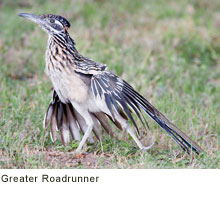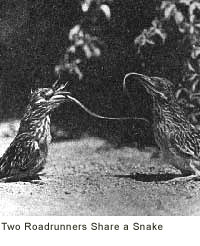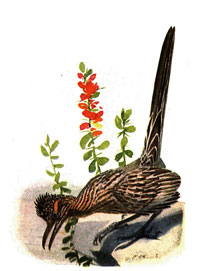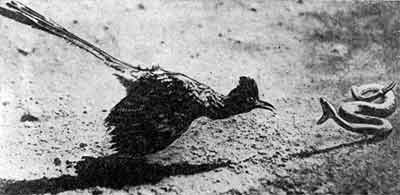|

 Weights and Measures: Roadrunner species generally range in size from 18-24 inches in length
from tail to beak. The roadrunner is large, slender, black-brown and
white streaked ground bird with a distinctive head crest. Weights and Measures: Roadrunner species generally range in size from 18-24 inches in length
from tail to beak. The roadrunner is large, slender, black-brown and
white streaked ground bird with a distinctive head crest.
It has long
legs, strong feet, and an oversized dark bill. The tail is broad with
white tips on the 3 outer tail feathers. During flight
the wings are short and rounded and reveal a white crescent in
the
primary feathers
Eye Patch:
They have a blank patch of
skin behind the eye that is shaded blue proximally to red distally. The
lesser roadrunner is slightly smaller, not as streaky, and has a
smaller bill. They are large long-legged birds with long thick dark
bills and long dark tails.

Fast on Their Feet: Roadrunners are terrestrial, and although capable
of flight, they spend most of their time on the ground. Roadrunners and other members of the cuckoo family
have zygodactyl feet (two toes in front and two toes in back).
Roadrunners are able to run up to 15 miles per hour and generally
prefer sprinting
to flying.
Greater Roadrunner Habitat: Their breeding habitat is desert and shrubby country in the southwestern United States and northern Mexico. They can be seen in the states of California, Arizona, New Mexico, Texas, Nevada, Utah, Colorado, Oklahoma, Kansas, and rarely in Arkansas and Louisiana. The Roadrunner is the state bird of New Mexico.
 Diet: Roadrunners are omnivores and are opportunistic. Their diet normally consist of insects (such as grasshoppers, crickets, catepillars, and beetles), small reptiles (such as lizards and snakes, including rattlesnakes), rodents and small mammals, tarantulas, scorpions, centipedes, spiders, small birds and fruits and seeds like prickly pear cactus and sumac. Diet: Roadrunners are omnivores and are opportunistic. Their diet normally consist of insects (such as grasshoppers, crickets, catepillars, and beetles), small reptiles (such as lizards and snakes, including rattlesnakes), rodents and small mammals, tarantulas, scorpions, centipedes, spiders, small birds and fruits and seeds like prickly pear cactus and sumac.
The lesser roadrunner eats mainly insects. Roadrunners forage on the ground usually running after prey under cover, they may leap to catch insects, and commonly batter certain prey, like snakes, against the ground.
Baby, it's Cold Outside: During the cold desert night the roadrunner lowers its body temperature slightly, going into a slight torpor to conserve energy. To warm itself during the day, the roadrunner exposes dark patches of skin on its back to the sun.

 Courtship: Cuckoos are commonly solitary birds Courtship: Cuckoos are commonly solitary birds
or live in pairs. They are monogamous and a pair
may mate for life. Pairs may hold a territory all year.
During the courtship display, the male bows, alternately lifting and dropping his wings
and spreading his tail. He parades in front of
the female with his head high and his tail and
wings drooped. It has also been documented
that the male may bring an offering of food
to the female. Roadrunners mate spring to mid-summer depending upon species and
geographic location.
Nest: Roadrunners nest are often
on a platform nest composed of sticks
(nest
may sometimes contain leaves, snakeskins, or dung). The nest are commonly placed in a low tree,
bush, or cactus.
Nestlings: Hatching is asynchronous and average a 2-6 egg clutch (the Lesser Roadrunners clutch size is typically smaller). Eggs are generally a white color. Roadrunners have bi-parental care. Both sexes incubate the nest and feed the hatchlings, but males incubate the nest at night. For the first one to two weeks after the young hatch, one parent always remains at the nest. After the hatchlings are two to three weeks old they leave and never return to the nest. For a few day thereafter, the parents and young forage together.

Roadrunner Trivia:
* The Greater Roadrunner is the state bird of New Mexico, USA.
* The Hopi and Pueblo Indian tribes believed that the roadrunner provided protection against evil spirits.
* The roadrunner has been called the war bird, the snake eater, and medicine bird by groups of Native Americans.
* The bird's Spanish name is paisano, which means "countryman".
* A Warner Brothers cartoon was created about Wile E. Coyote and Road Runner.
* Geococcyx sp. is the only real predator of the tarantula hawk wasp.
* The mascots of California State University, Bakersfield and University of Texas at San Antonio are roadrunners.

All text is available under the terms
of the GNU Free Documentation License
|